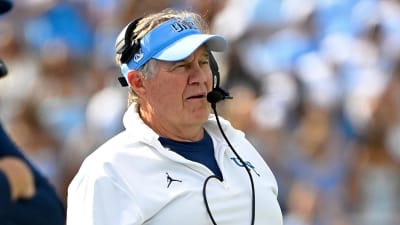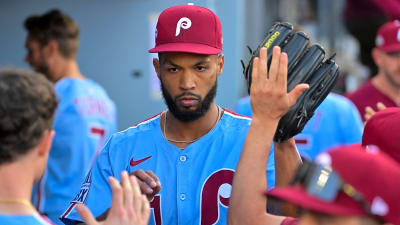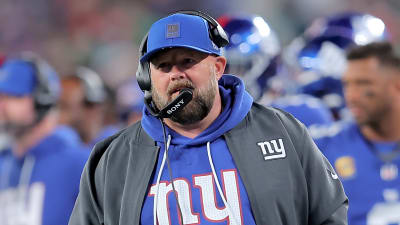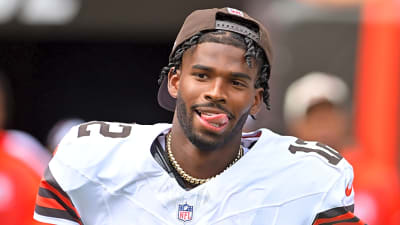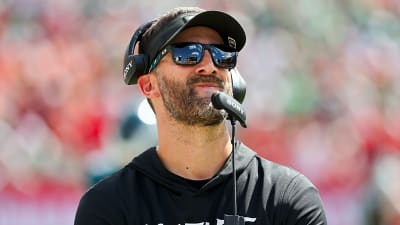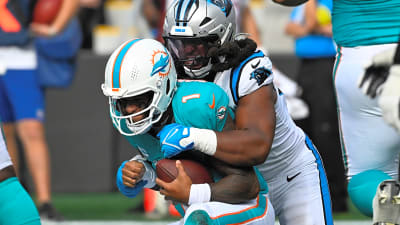
Since the season kicked off in Week 1, there have been seven trades so far in the first six weeks. If all the buzz from the insiders is correct, there could be at least that many in the next few weeks before the trade deadline on Tuesday, November 4.
But for now we’ll take a look backward at the deals that have been wrapped up already, grading every trade to see who the winners and losers are so far:
Jaguars/Browns
Jaguars get:
- CB Greg Newsome
- 2026 6th
Browns get:
- CB Tyson Campbell
- 2026 7th
Player-for-player trades aren’t common, especially during the season and especially involving two starting players. But the Browns and Jaguars have two of the most unconventional front offices in football. They already swung one big trade back during the draft that led to Jacksonville moving up for two-way WR/CB Travis Hunter at No. 2 overall, and that familiarity likely played a role in this current deal swapping starting cornerbacks.
At first glance, this is a confusing trade to get a handle on. Newsome and Campbell are similar-caliber players — solid starters, probably good enough to be the top option for a lot of teams, but not true shutdown players. Both were drafted in 2021 just seven picks apart, as Newsome went in the first round at No. 26 overall and Campbell was the first pick of the second round at No. 33. They both are 25 years old and they both are about the same size at over 6-0 and 190 pounds.
Both players have been up and down to start their careers. Campbell has the best single season of the two with an outstanding 2022 year with 15 pass breakups and three picks. Since then, injuries and coaching instability have impacted his play. Newsome’s best seasons, including this one so far, have been when he was able to play outside corner, but the Browns saw it fit to play him in the slot more often than not.
The biggest difference in the two is their contract. Campbell was eligible for a new deal before Newsome since he signed a four-year deal as a second-round pick, as opposed to Newsome’s first-round deal that included a fifth-year option. Newsome’s on that option right now for a sum of $13.77 million and will be an unrestricted free agent in March. Based on how he’d played so far and the perpetual demand around the league for decent cornerback play, Newsome could be in line for a deal worth $18-$20 million a year.
Campbell already signed a four-year, $76.5 million deal going into last year with the Jaguars, a deal approved by former GM Trent Baalke, not current GM James Gladstone. That matters a lot for these kinds of decisions and the Jaguars have already moved on from a number of players who weren’t viewed as scheme fits. Campbell falls in that bucket, as he’s at his best in man coverage while current Jaguars DC Anthony Campanile wants corners who can sit back in zone and come forward to make plays on the ball.
Campbell’s a much better fit for Browns DC Jim Schwartz’s man-heavy scheme. He’s also under contract for three more years and a total of $45.6 million, only $13.1 million of which is guaranteed. That matters a lot for the Browns since not only is Newsome not under contract, neither is CB Martin Emerson who was set to start before tearing his Achilles during training camp. In theory, adding Campbell gives the Browns a long-term solution at cornerback.
Cleveland gave up the higher pick in the deal, which suggests that Campbell was viewed as the better player/asset. But it’s not a major difference, and this seems to read more like a win-win deal for both sides, depending on how things shake out on the field for both Campbell and Newsome from this point on. Jacksonville not only gets a player who could be a potentially better fit in their secondary, but also gains spending flexibility with Campbell’s contract off the books. If they don’t re-sign Newsome, they could put themselves in line for a nice compensatory pick if he ends up signing a big deal.
Jaguars grade: B
Browns grade: B+
Chargers/Ravens
Chargers get:
- OLB Odafe Oweh
- 2027 7th
Ravens get:
- S Alohi Gilman
- 2026 5th
Heading into Week 6, the Ravens were 1-4 with their sky-high preseason hopes on perilously thin ice. The primary culprit was the defense, which allowed 37 or more points in four of the first five games, and an avalanche of injuries since then has left the Ravens feeling snowed under. Baltimore almost had no choice but to make a dramatic move to try and stem the bleeding, and that resulted in yet another player-for-player trade.
The Ravens dealt away a player in Oweh who was a former first-round pick and had 10 sacks last year in a breakout performance. Baltimore only had six sacks entering Week 6, but Oweh had none and was only playing 45 percent of the snaps — third among the edge rushers on the team. It’s harsh but he wasn’t playing like the essential piece he was drafted to be.
In return, the Ravens shed the remainder of Oweh’s $13.251 million salary from his fifth-year option, clearing up over half of that and giving them more flexibility for another in-season move or two, if they choose. They also added a veteran safety in Gilman who can help shore up a different area on defense, one that’s key to playing better football in the second half of the season for the Ravens. The Chargers run the same system as the Ravens, as DC Jesse Minter was a former Baltimore assistant, so that should help Gilman get up to speed quickly. He’s also in a contract year, giving the Ravens options on how to proceed after the season.
The draft pick compensation isn’t massive but it’s not insubstantial as far as Day 3 swaps go, moving a seventh-round pick up a year and two rounds. It’s an extra, secondary benefit to the cash savings and acquiring Gilman, giving Baltimore another potential avenue to getting value out of this move.
For the Chargers, this is the front office taking a swing at adding a pass rusher with relatively little risk — at least in terms of cost. Oweh has pedigree as a former first-round pick who tested like an elite athlete, and he’s spent his entire career in a similar system to what the Chargers run even if he didn’t overlap with Minter in Baltimore or with HC Jim Harbaugh in the Big 10. Pass rush is one of the weaknesses for an otherwise solid Chargers defense, and the hope in adding Oweh is that a fresh start will help him tap back into the version of him last year that hit double-digit sacks.
If it goes well, the Chargers will have the option to franchise Oweh, extending their exclusive window to negotiate a long-term deal that runs from now until March. If it doesn’t, they didn’t give up assets that will be crippling in the long run. Gilman was set to be a free agent and they netted out the same number of picks. They could even come out ahead if Oweh ends up qualifying for a compensatory pick down the line.
There is some risk in jettisoning a veteran who was playing 87 percent of the snaps before the trade, especially for a communication-heavy system like Minter runs. Evidently, though, the Chargers felt comfortable in their remaining defensive backs to pick up the slack, enough to roll the dice on getting an upgrade at a more premium position.
Ravens grade: B
Chargers grade: B+
Browns/Bengals
Browns get:
- 2026 5th
Bengals get:
- QB Joe Flacco
- 2026 6th
The Bengals thought they’d be just fine with backup QB Jake Browning, like they were the last time starting QB Joe Burrow missed significant time in 2023. But in Browning’s three starts, the team was shockingly uncompetitive. Cincinnati lost to the Vikings, Broncos and Lions by scores of 48-10, 28-3 and 37-24. Browning had four touchdowns, five interceptions and averaged 172 passing yards per start. Most importantly, by his third start against the Lions, Browning looked like a quarterback whose confidence was completely shattered.
The Bengals didn’t have any good options but the worst one might have been to do nothing. They called around the league to see who had a quarterback available for trade and the result of that was a deal for Flacco, just a week after he’d been benched by the Browns a few weeks earlier than expected. He wasn’t playing a whole lot better than Browning — PFF ranked Flacco 30th out of 36 qualifying quarterbacks compared to 35th for Browning — but the Bengals hoped he’d be able to provide a bit of a spark.
If you’ve heard the phrase “re-arranging the deck chairs on the Titanic,” that might be the best way to sum up this deal. This is unlikely to change much of anything for the Bengals. Flacco is more experienced, more reliable and a better thrower than Browning, but the net result is unlikely to give the Bengals anywhere near the level of quarterback play they need to stay afloat the rest of this season. In his first start, Flacco didn’t turn the ball over and had two touchdowns, but also averaged less than five yards per attempt in a 27-18 loss to the Packers.
Fortunately, Flacco was cheap, both in terms of salary and acquisition cost. His base salary for 2025 was just $2.5 million and the Bengals only gave up about a round or so of draft positioning on Day 3 next year. For a move they had to make, it’s a reasonable price. And hey, there’s always a chance Flacco taps into some magic as we’ve seen him do for short stretches of his career at a time.
For the Browns, they’re leaning as much into the idea of a multi-year rebuild as any team since the tanking 2019 Dolphins. Once they made the decision to turn to third-round QB Dillon Gabriel and he didn’t look over his head, Flacco became extraneous to their goals. Trading him only marginally improves their draft capital but given the headwinds the Browns have to fight against with their roster situation over the next few seasons, winning on the margins will be imperative.
Bengals grade: C+
Browns grade: B-
Browns/Texans
Browns get:
- OT Cam Robinson
- 2027 7th
Texans get:
- 2027 6th
The Browns might not look like a team that would be looking to add veterans during the season but teams have to make different considerations when it comes to the offensive line. Even replacement-level O-line play can be hard to come by when injuries start thinning the depth chart for teams. And without good offensive line play, it becomes incredibly hard to do anything on offense.
The Browns are more concerned about developing their young players on offense than they are winning games, but the injuries at tackle were getting to a point where the team risked sabotaging the learning curve for some of their youngsters. That prompted the trade for Robinson to try and stabilize the position with a veteran. Robinson was only an average tackle at the peak of his career and couldn’t win a job for a Texans team that was navigating its own offensive line issues, but it’s hard to replicate the sheer number of reps he’s had in the NFL.
Cleveland didn’t give up much for Robinson with the late-round pick swap, and he was only due $3.25 million in-season after the Texans paid him an $8.75 million signing bonus. That was a big whiff for Houston and I’m not necessarily sure that trading Robinson makes it any better, as it’s never a bad thing to have too much depth along the offensive line. Then again, if he was going to be a locker room issue, moving on now makes sense.
Texans grade: C
Browns grade: C+
Titans/Jets
Titans get:
- 2026 6th
Jets get:
- CB Jarvis Brownlee
- 2026 7th
Based on the information that’s publicly available, this trade made very little sense for the Titans. Brownlee was a fifth-round pick just last year who started 14 games and played 86 percent of the snaps for Tennessee as a rookie. He wasn’t a perfect player by any means — he had 12 penalties in 19 games as a Titan and played primarily outside corner when he was probably a better fit in the slot. But he was productive, young and cheap. Jettisoning a player like that for peanuts doesn’t seem to make sense for a rebuilding team like the Titans.
Sometimes there’s stuff going on behind the scenes in meeting rooms, practice and the locker room that makes a deal like this make more sense. There have been whispers of issues like that with Brownlee, but not much in the way of concrete reporting. Absent that, this has to be graded as a whiff for the Titans, who are shorthanded and struggling in the secondary.
For the Jets, this has a chance to be a real personnel win for the brand-new regime. Brownlee played major snaps in Week 6 against the Broncos and was active with a tackle for loss among his five solo takedowns. The Jets should be able to play him in the slot where he’s at his best, and if he turns into a starting player, that’s a big win given he was essentially free.
Titans grade: D
Jets grade: A-
Saints/Patriots
Saints get:
- WR Ja’Lynn Polk
- 2028 7th
Patriots get:
- 2027 6th
Polk was regularly featured in our preseason trade block, as the 2024 second-round pick had fallen deep down the depth chart following a tough rookie season and New England’s decision to jettison the coaching staff that drafted him. Then he went down with a season-ending injury, which tanked his trade value even further. The Patriots getting anything at all for him is notable, though a late-round swap involving a pick three years out is about as bottom of the barrel as it gets for compensation.
The bet for the Saints is that a change of scenery can help Polk play more like the second-round pick he was drafted as, which would give New Orleans a starting receiver on a cheap deal for the next two years. The Athletic’s Dane Brugler compared Polk to Bills WR Josh Palmer as a reliable, chain-moving option who could contribute as a blocker as well.
If it doesn’t work, the biggest thing the Saints will be out is cash. They picked up a total of $3.479 million in remaining guarantees on Polk’s contract, including $1.2 million this year. That’s not a lot of money over three years, but the Saints are effectively paying Polk an advance by picking up his salary this year while he’s out on injured reserve. They probably could have done this same trade in March and let the Patriots pay the bill until then, which is why I like this deal slightly more for New England than I do New Orleans.
Patriots grade: B
Saints grade: C
Jaguars/Eagles
Jaguars get:
- 2026 5th
- 2026 6th
Eagles get:
- RB Tank Bigsby
Eagles GM Howie Roseman has a (well-earned) reputation as a shrewd and fearless dealmaker, the architect of a team that’s been to three Super Bowls in the past eight years and won two. No one hits on all their moves, though. It’s too early to completely write off this deal for Bigsby but it was curious at the time and it has not aged much better over the past few weeks. Bigsby has five carries on the season, none of which have come in an Eagles jersey.
So why make the trade? The Eagles cited Bigsby’s ability as a kickoff returner after making the deal, especially because the play has been thrust to the forefront with renewed prominence after this past offseason’s rule changes. It’s created a chance for good teams to create edges ahead of teams that are slower to adjust, and that appears to be what the Eagles were trying to do. Bigsby had six returns for 195 yards last year — a 32.5 average.
Unfortunately it hasn’t panned out. Bigsby has returned 10 kickoffs this year for 207 yards, nearly all of those for the Eagles. He ranks 42nd out of 43 players with enough returns to qualify with an average of just 20.7 yards. Even fielding the kickoffs has been an adventure at times, as now that teams are more incentivized to put the ball in play, kickers have unveiled these knuckleball kicks that move and twist unpredictably.
The good news for the Eagles is that Bigsby is under contract for another year on a cheap rookie deal, so there’s time for him to make contributions and justify the acquisition cost. At the moment, though, two picks, including a fift,h looks like highway robbery for the Jaguars, who are chugging along just fine in their backfield and return game.
Eagles grade: D
Jaguars grade: A
More must-reads:
- Chiefs QB Patrick Mahomes reaches career milestone vs. Lions
- Titans HC Brian Callahan calls out Cam Ward after loss to Raiders
- The 'Most starts by an NFL quarterback' quiz
Breaking News
Trending News
Customize Your Newsletter
 +
+
Get the latest news and rumors, customized to your favorite sports and teams. Emailed daily. Always free!
